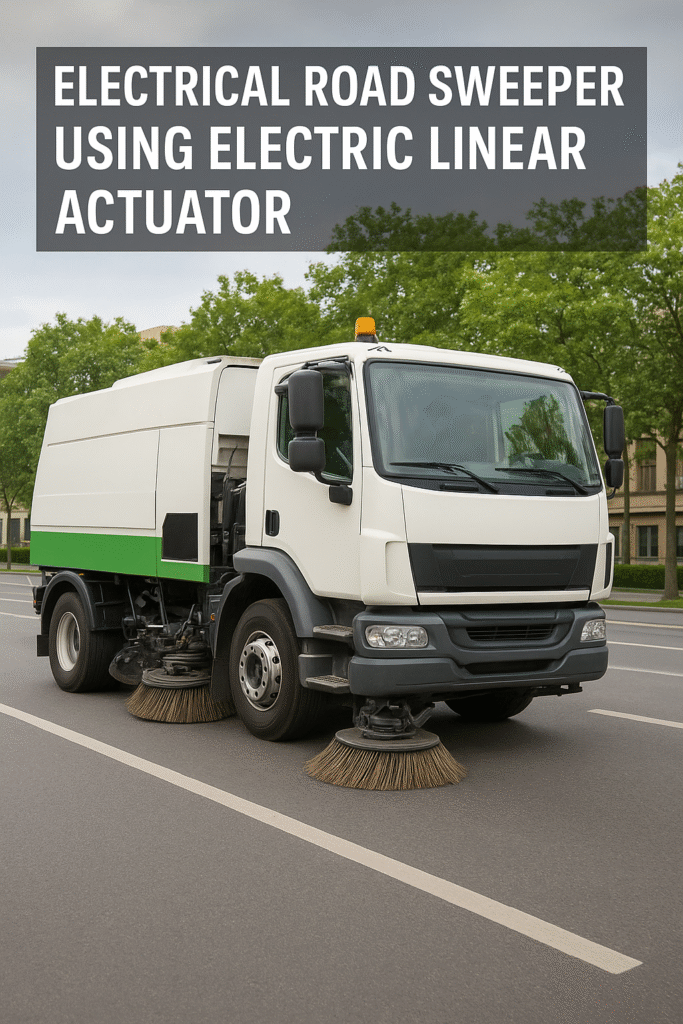Clean roads are a hallmark of modern cities. From metro streets to industrial zones, municipalities and private contractors invest heavily in road sweeping machines to ensure hygiene, safety, and aesthetics. Traditionally, most sweepers use hydraulic systems to operate brushes, bins, and suction units. While effective, these systems often bring drawbacks—oil leaks, complex maintenance, and high energy use, Electrical.
With growing emphasis on sustainability and smart city solutions, the shift is happening toward electric road sweepers powered by electric linear actuators. These actuators not only simplify motion control but also make street-cleaning machines more reliable, efficient, and eco-friendly.

Why Electric Linear Actuators Are Ideal for Road Sweepers
- Precision Brush Control
The cleaning quality of a road sweeper depends on how effectively the brushes adjust to road surfaces. Electric actuators allow fine-tuned height and angle adjustment, ensuring consistent cleaning across uneven roads. - Eco-Friendly Operation
With no hydraulic oil, there’s no risk of fluid leakage polluting streets. This is critical for both urban areas and eco-sensitive regions. - Quiet City Cleaning
Unlike noisy hydraulic pumps, electric actuators run smooth and silent, making them perfect for nighttime or early-morning cleaning without disturbing residents. - Energy Savings
Electric actuators only consume power when moving, unlike hydraulic systems that keep pumps running continuously. This means longer battery life in electrical sweepers. - Low Maintenance
With fewer components and no fluid management, actuators drastically reduce downtime and servicing costs.
Key Applications of Electric Actuators in Road Sweepers
- Brush Adjustment – Automatic control of sweeping brush height and pressure.
- Debris Hopper Control – Smooth tilting of the hopper for waste unloading.
- Vacuum & Suction Control – Actuators manage opening and closing of suction units.
- Water Spray Systems – Actuator-driven nozzles adjust angles to suppress dust effectively.
- Cabin Comfort – Electric actuators can also be used in operator seat and control panel adjustments.
A Story of Smarter Cleaning
Imagine a late-night road sweeping operation in a busy metro city. An electric road sweeper glides quietly along the street. As it detects varying dust levels, the actuators automatically lower the brushes, adjust pressure for optimal cleaning, and activate precisely directed water spray to suppress dust.
Once the hopper is full, the operator simply presses a button, and electric actuators tilt the bin to unload the debris without any hydraulic oil mess. The sweeper continues seamlessly, reducing downtime and ensuring streets are spotless by dawn.
The Future of Smart Road Sweepers
As smart cities evolve, the integration of sensors, IoT, and AI with electric actuators will make road sweepers even more intelligent. Future sweepers will:
- Adjust brush height automatically using road surface sensors.
- Optimize actuator movements for energy savings.
- Provide real-time performance data for predictive maintenance.
This not only improves urban cleanliness but also supports sustainability goals by eliminating hydraulics and reducing carbon footprint.
Conclusion
The shift toward electric actuators in electrical road sweepers is a significant step in urban innovation. By providing precision, energy efficiency, and eco-friendly performance, actuators make sweepers smarter, quieter, and more reliable.
For municipalities and industries aiming for cleaner streets and sustainable infrastructure, electric linear actuators are the technology that will pave the way to the future of smart cleaning.
